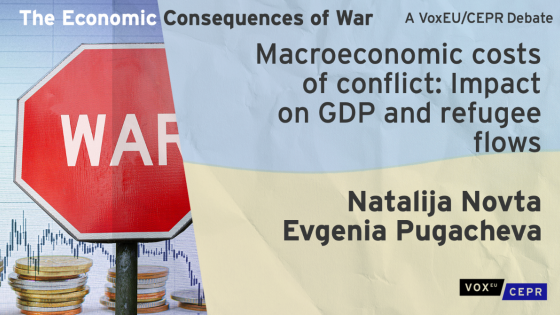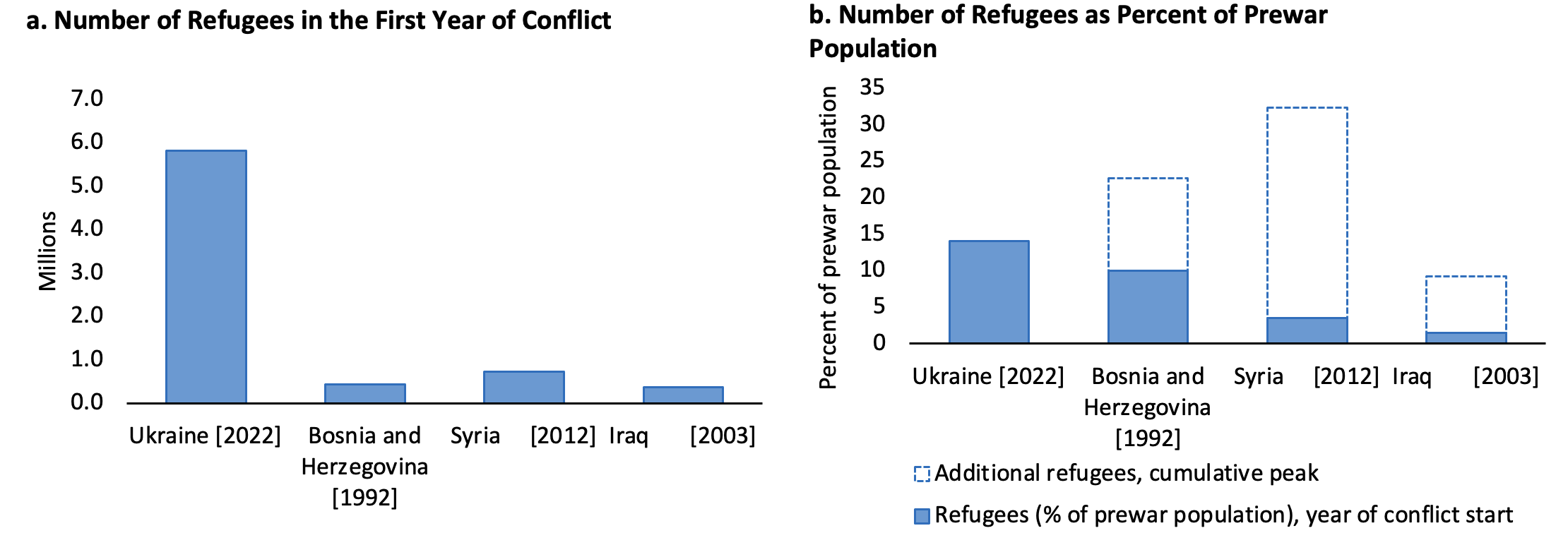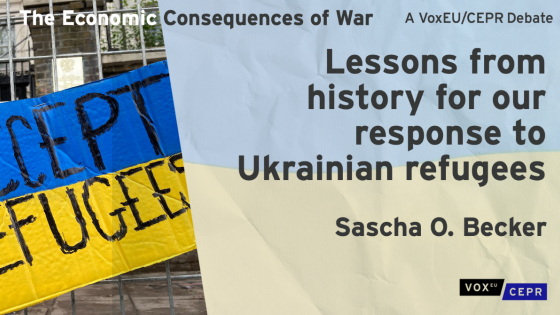Editors' note: This column is part of the Vox debate on the economic consequences of war.
Estimation of the impact of the war in Ukraine is hampered by availability of data and the evolving situation on the ground (Constantinescu et al. 2022). According to the latest forecasts by the IMF (2022), the Ukrainian economy is expected to shrink by over 35% in 2022. Given high uncertainty, the recovery path could be prolonged (Blinov and Djankov 2022). To put this outlook in context, our recent paper on the macroeconomic costs of conflict (Novta and Pugacheva 2021) sheds light on the range of possible economic outcomes after the onset of a large-scale war.1 We analyse all major conflict episodes over the past 30 years and estimate the macroeconomic costs of war in terms of the impact on GDP and its components, as well as refugee flows. While there can be a lot of variation in outcomes, depending on individual conflict and country characteristics, we find that wars tend to be highly disruptive for at least a decade after onset, affecting all parts of the economy, in addition to the incalculable humanitarian losses.
Impact of conflict on GDP and its components
First, using local projections (Jordà 2005), we find that the macroeconomic costs of conflict are very large, with GDP per capita about 28% lower ten years after conflict onset (Figure 1).2 This is overwhelmingly driven by private consumption, which falls by almost 25%. Conflict is also associated with dramatic declines in official trade, with exports estimated to be 58% lower and imports 34% lower ten years after conflict onset. Public spending does not systemically decline following conflict onset, perhaps because of increased military spending, combined with lower spending on other goods and services. Investment usually falls in the year of conflict onset, but the effect is imprecisely estimated in later years.
Disaggregating GDP into agriculture, manufacturing, and services, we find that conflict is associated with a decline in production across all sectors. Agriculture value added decreases by 6% in the year of conflict onset, with the effect remaining negative and statistically significant for the next five years. Manufacturing declines by 16% in the year of conflict onset and by 38% cumulatively ten years after the shock. Services decline by 12% on impact and by 30% ten years after the shock. Such long-lasting effects paint a grim picture given that Ukraine is a major producer and exporter of agricultural goods, and its manufacturing sector is well integrated into international supply chains.
Figure 1 Impact of conflict on GDP and its components
Sources: IMF, World Economic Outlook; World Bank, World Development Indicators; and authors' calculations.
Note: The analysis includes 37 major conflict episodes in a sample of 188 countries over 1989-2018. Conflict onset is defined as the year when at least 100 people were killed per 1 million population following at least 4 years of no conflict in the preceding period. Estimates are based on local projections and show the impact of conflict onset on GDP per capita and other indicators in the year of conflict onset (0 on the x-axis), the year following conflict onset (+1 on the x-axis), etc. Dashed lines indicate 95% confidence intervals.
Impact of conflict on the number of refugees
With 5.8 million Ukrainians registered as refugees by July 2022 (UNHCR 2022), the unfolding war in Ukraine has no precedent in recent history in terms of the number of refugees at the start of conflict (Figure 2a).3 In part this is because Ukraine, with a pre-war population of over 40 million people, is among the 40 most populous countries in the world. But in terms of the number of refugees as a share of pre-war population, the situation in Ukraine does resemble that of Bosnia and Herzegovina, where close to 10% of the population fled in the first year of conflict, approximately doubling over the next four years (Figure 2b). The war in Ukraine and the Yugoslav wars are also the only two conflicts within the European continent since WWII. If the Ukrainian refugee situation develops as in Bosnia and Herzegovina, the total number of refugees from Ukraine could reach up to ten million people, a potential situation for which the rest of the world must be prepared.
Figure 2 Number of refugees by country
Sources: UNHCR; and authors' calculations.
Note: Number of refugees for Ukraine is as of July 13, 2022.
Looking at historical data, conflict onset often induces significant refugee outflows to neighbouring non-advanced countries in the short run (given the location of most conflict-affected countries), and typically small but very persistent refugee outflows to non-neighbouring advanced countries over the long run. After a large influx of refugees following conflict onset, the cumulative growth of the number of refugees to neighbouring countries is 2.8% relative to the pre-conflict level and remains mostly stable over time (Figure 3a). This means that refugees typically come to neighbouring countries within the first year of conflict, and often stay for five years or more after. Looking at refugees in advanced economies, the growth is extremely persistent and continues even five years after conflict onset (Figure 3b). For Ukraine, the advanced economies of Europe are geographically closer, with many friends and family already working there and ready to help. In this context, Bosnia is likely the closest historical comparator to Ukraine.
Figure 3 Impact of conflict on the number of refugees
Sources: UNHCR; and authors' calculations.
Note: X-axis shows years, with -1 referring to the year before conflict onset, 0 the year of conflict start, +1 the year following the conflict, etc. Dashed lines indicate 95% confidence intervals.
Conclusion
With the prospect of such large refugee flows, European countries will need comprehensive long-term policies for the integration of refugees into the local labour markets, as well as support for families with children and the elderly (Angrist et al. 2022, Becker 2022, Blinov and Djankov 2022). The post-conflict reconstruction often required policies different from those used for stabilisation after other severe economic shocks such as a banking or currency crisis. Chami et al. (2021) and United Nations and World Bank (2018) discuss ways to adjust macroeconomic stabilisation policies to meet the specific challenges facing individual fragile and conflict-affected states. These focus on strengthening governance, rebuilding trust in institutions, rebuilding tax capacity to mobilise revenues, and providing a fully functioning formal economy. International organisations such as the International Monetary Fund, as well as European partners, have an important role to play, as outlined in the potential blueprint for Ukraine’s reconstruction in Becker et al. (2022). With Ukraine’s high level of human capital and aid from the international community there is hope that a swift reconstruction and recovery is possible.
Authors’ note: The views expressed herein are those of the authors and should not be attributed to the IMF, its Executive Board, or its management.
References
Angrist, N, S Djankov, P Goldberg and H Patrinos (2022), “The Loss of Human Capital in Ukraine”, VoxEU.org, 27 April.
Becker, S O (2022), “Lessons from History for our Response to Ukrainian Refugees”, VoxEU.org, 29 March.
Becker, T, B Eichengreen, Y Gorodnichenko, S Guriev, S Johnson, T Mylovanov, K Rogoff and B Weder di Mauro (2022), “A Blueprint for the Reconstruction of Ukraine”, VoxEU.org, 07 April.
Blinov, O and S Djankov (2022), “Ukraine’s Deepening Population Challenge”, VoxEU.org, 28 June.
Chami, R, R Espinoza and P Montiel (2021), Macroeconomic Policy in Fragile States, Oxford University Press, United Kingdom.
Constantinescu, M, K Kappner and N Szumilo (2022), “Estimating the Short-Term Impact of War on Economic Activity in Ukraine”, VoxEU.org, 21 June 2022.
International Monetary Fund (2022), World Economic Outlook: War Sets Back the Global Recovery, April.
Jordà, Ò (2005), “Estimation and Inference of Impulse Responses by Local Projections”, American Economic Review 95(1): 161–182.
Mueller, H (2016), “Growth and Violence: Argument for a Per Capita Measure of Civil War”, Economica 83: 473–497.
Novta, N and E Pugacheva (2021), “The Macroeconomic Costs of Conflict”, Journal of Macroeconomics 68.
Sundberg, R and E Melander (2013), “Introducing the UCDP Georeferenced Event Dataset”, Journal of Peace Research 50(4): 523-532.
United Nations and World Bank (2018), “Pathways for Peace: Inclusive Approaches to Preventing Violent Conflict”, World Bank, Washington, DC.
United Nations High Commissioner for Refugees (UNHCR) (2022), “Operational Data Portal: Ukraine Refugee Situation”, Accessed 13 July 2022.
Endnotes
1 We define conflict onset based on the share of population killed, as in Mueller (2016). We focus on conflicts in which 100 people were killed per one million population in the first year of conflict, which is defined if there was no conflict in the preceding four years. Our analysis indicates that the effect of conflict tends to be underestimated if the more standard definition of 1,000 deaths is used to define a conflict episode. If several distinct conflicts were happening in the country in the same year, we add the numbers to have a single country-year observation. Over the period 1989-2018 our sample includes 37 such episodes. Data on the number of fatalities are from the Uppsala Conflict Data Program (UCDP) Georeferenced Event Dataset (Sundberg and Melander 2013).
2 When using real GDP per capita we employ population data from the same year as the GDP data.
3 We focus on the number of refugees reported by the UNHCR. Many more people have been internally displaced or are registered as asylum seekers.






